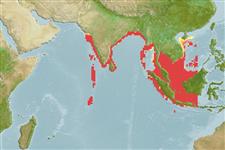>
Scombriformes (Mackerels) >
Scombridae (Mackerels, tunas, bonitos) > Scombrinae
Etymology: Scomberomorus: Latin, scomber = mackerel + Greek, moros = silly, stupid (Ref. 45335).
More on author: Cuvier.
Environment: milieu / climate zone / depth range / distribution range
Ecologia
marinhas; oceanódromo (Ref. 51243). Tropical; 24°N - 11°S, 70°E - 115°E (Ref. 168)
Indo-West Pacific: west coast of India and Sri Lanka eastward to Thailand, Malaysia and Java (Ref. 9684). Does not extend further out in the East Indies (Ref. 9684).
Length at first maturity / Tamanho / Peso / Idade
Maturity: Lm 70.0 range ? - ? cm
Max length : 94.0 cm FL macho/indeterminado; (Ref. 168); 98.0 cm (female); common length : 70.0 cm FL macho/indeterminado; (Ref. 9684)
Espinhos dorsais (total): 15 - 18; Raios dorsais moles (total): 15-19; Raios anais moles: 17 - 22; Vértebras: 44 - 46. A unique pigment pattern of short lines on the sides which distinguishes from all other species of Scomberomorus; maxilla with the posterior end greatly expanded; parasphenoid wide (Ref. 10996). Interpelvic process small and bifid. Lateral line without auxiliary branches anteriorly, running almost straight below second dorsal finlet then slightly bent downward toward keel of caudal peduncle. Intestine with 2 folds and 3 limbs. Swim bladder absent. Body covered with small scales. First dorsal fin black posteriorly.
Unlike S. commerson and S. guttatus, S. lineolatus is not encountered in very turbid waters or much reduced salinity. Feeds primarily on fishes. Also taken with midwater trawls, purse seines and by trolling (Ref. 9684). Taken from Oct.-Nov. along the Thai coast, Indian Ocean; in Malaysia Nov.-Feb. in the west coast, Mar.-Jul. in the south, Feb.-Mar. and Aug.-Nov. in the east; in India from May-Sept. with other seerfishes. Marketed mainly fresh; also dried-salted (Ref. 9684). Also consumed as spicy fishballs.
Collette, B.B. and C.E. Nauen, 1983. FAO Species Catalogue. Vol. 2. Scombrids of the world. An annotated and illustrated catalogue of tunas, mackerels, bonitos and related species known to date. Rome: FAO. FAO Fish. Synop. 125(2):137 p. (Ref. 168)
Categoria na Lista Vermelha da IUCN (Ref. 130435)
Ameaça para o homem
Harmless
Utilização humana
Pescarias: espécies comerciais; peixe desportivo: sim
Mais informação
ReferênciasAquaculturaPerfil para aquaculturaEstirpesGenéticaElectrophoresesHereditariedadeDoençasProcessamentoNutrientsMass conversion
ColaboradoresFotografiasStamps, Coins Misc.SonsCiguateraVelocidadeTipo de nataçãoÁrea branquialOutras referênciasCérebrosVisão
Ferramentas
Relatórios especiais
Descarregue XML
Fontes da internet
Estimates based on models
Preferred temperature (Ref.
123201): 23.8 - 28.6, mean 27.7 °C (based on 595 cells).
Phylogenetic diversity index (Ref.
82804): PD
50 = 0.5000 [Uniqueness, from 0.5 = low to 2.0 = high].
Bayesian length-weight: a=0.00692 (0.00371 - 0.01290), b=2.99 (2.83 - 3.15), in cm total length, based on LWR estimates for this species & Genus-body shape (Ref.
93245).
Nível Trófico (Ref.
69278): 4.5 ±0.80 se; based on food items.
Resiliência (Ref.
120179): Médio, tempo mínimo de duplicação da população 1,4 - 4,4 anos (K=0.18-0.22; tm=2; Fec=560,000).
Fishing Vulnerability (Ref.
59153): Very high vulnerability (82 of 100).
Climate Vulnerability (Ref.
125649): Very high vulnerability (82 of 100).
Nutrients (Ref.
124155): Calcium = 31.6 [14.0, 106.5] mg/100g; Iron = 0.806 [0.360, 1.933] mg/100g; Protein = 20.6 [19.3, 21.8] %; Omega3 = 0.267 [0.165, 0.431] g/100g; Selenium = 58.3 [21.7, 190.0] μg/100g; VitaminA = 25.5 [6.3, 113.2] μg/100g; Zinc = 0.659 [0.434, 1.038] mg/100g (wet weight);
